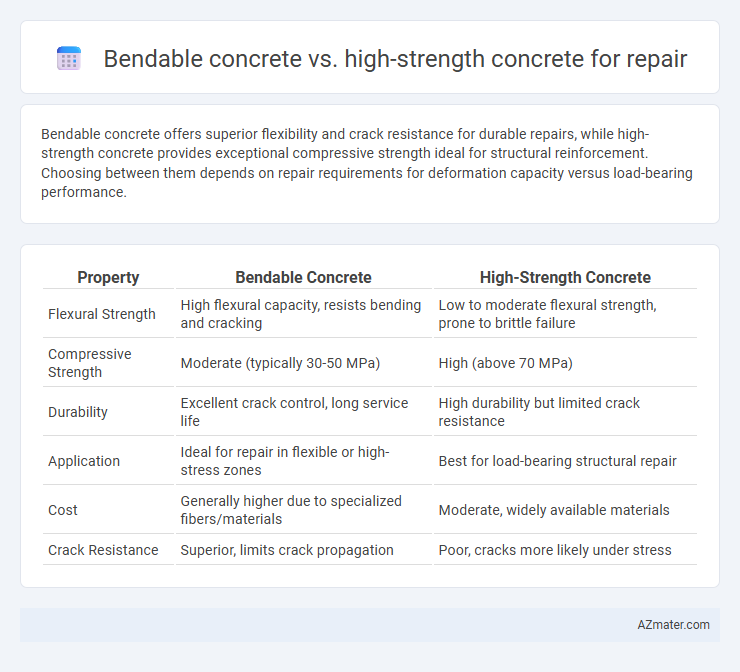Bendable concrete offers superior flexibility and crack resistance for durable repairs, while high-strength concrete provides exceptional compressive strength ideal for structural reinforcement. Choosing between them depends on repair requirements for deformation capacity versus load-bearing performance.
Table of Comparison
| Property | Bendable Concrete | High-Strength Concrete |
|---|---|---|
| Flexural Strength | High flexural capacity, resists bending and cracking | Low to moderate flexural strength, prone to brittle failure |
| Compressive Strength | Moderate (typically 30-50 MPa) | High (above 70 MPa) |
| Durability | Excellent crack control, long service life | High durability but limited crack resistance |
| Application | Ideal for repair in flexible or high-stress zones | Best for load-bearing structural repair |
| Cost | Generally higher due to specialized fibers/materials | Moderate, widely available materials |
| Crack Resistance | Superior, limits crack propagation | Poor, cracks more likely under stress |
Introduction to Bendable and High-Strength Concrete
Bendable concrete, also known as engineered cementitious composite (ECC), is designed to flex and distribute stress through microcracking, making it highly durable for repair applications where flexibility and crack resistance are critical. High-strength concrete, characterized by a compressive strength exceeding 6,000 psi, offers superior load-bearing capacity and is commonly used for structural repairs demanding enhanced mechanical performance. Selecting between bendable and high-strength concrete depends on the specific repair requirements, including the need for durability under deformation or increased structural strength.
Key Properties of Bendable Concrete
Bendable concrete offers superior flexibility and crack resistance due to its engineered fiber reinforcement, enabling it to absorb tensile stresses better than traditional high-strength concrete, which primarily excels in compressive strength. This ductility reduces repair frequency and enhances durability in dynamic or load-varying environments, making bendable concrete ideal for infrastructure subject to seismic or heavy traffic stresses. High-strength concrete, while providing exceptional compressive capacity, lacks the strain-hardening behavior and toughness necessary for effective crack control during repairs.
Key Properties of High-Strength Concrete
High-strength concrete (HSC) is characterized by a compressive strength typically exceeding 6,000 psi, offering superior durability and load-bearing capacity for structural repairs. Its low water-to-cement ratio enhances resistance to environmental degradation, reducing permeability and improving longevity in repair applications. Compared to bendable concrete, HSC provides exceptional rigidity and is ideal for repairs requiring high compressive performance and minimal deformation.
Applications in Concrete Repair Projects
Bendable concrete, characterized by its high ductility and crack resistance, is ideal for repair applications requiring enhanced durability in seismic zones and flexible pavement repairs, reducing maintenance frequency. High-strength concrete, noted for its compressive strength above 6000 psi, is preferable in structural repairs where load-bearing capacity restoration is critical, such as bridges and high-rise buildings. Selecting between bendable and high-strength concrete depends on the specific demands of the repair project, balancing flexibility and strength for optimal longevity.
Durability and Flexibility Comparison
Bendable concrete offers superior flexibility compared to high-strength concrete, allowing it to withstand tensile stresses and minor deformations without cracking, which significantly enhances durability in repair applications subjected to dynamic loads. High-strength concrete provides exceptional compressive strength but tends to be brittle, making it more prone to cracking under flexural or tensile stresses during structural repairs. For repairs requiring resilience against deformation and crack propagation, bendable concrete delivers increased lifespan and reduced maintenance due to its enhanced flexibility and toughness.
Crack Resistance and Self-Healing Capabilities
Bendable concrete exhibits superior crack resistance due to its high tensile strain capacity, allowing it to flex and accommodate structural movements without fracturing. High-strength concrete, while offering greater compressive strength, is more prone to brittle failure and microcracking under stress. The self-healing capabilities of bendable concrete are enhanced by its crack width control, promoting effective autogenous healing, whereas high-strength concrete typically requires additives or engineered fibers to achieve similar healing performance.
Cost and Economic Considerations
Bendable concrete offers significant cost savings in repair projects due to its enhanced flexibility, reducing crack propagation and lowering long-term maintenance expenses compared to high-strength concrete. High-strength concrete, while providing superior compressive strength, often incurs higher initial material and labor costs, impacting overall project budgets. Economic considerations favor bendable concrete for repair applications where durability and reduced lifecycle costs outweigh the premium strength benefits of traditional high-strength mixes.
Installation and Maintenance Requirements
Bendable concrete offers superior flexibility and crack resistance, reducing the need for frequent repairs and simplifying installation with its ability to conform to various shapes without compromising structural integrity. High-strength concrete requires careful mixing and curing processes during installation to achieve its durability, often demanding more specialized labor and equipment. Maintenance for bendable concrete is generally less intensive due to its enhanced toughness, while high-strength concrete may necessitate regular inspections to address potential brittleness or micro-cracking over time.
Environmental Impact and Sustainability
Bendable concrete significantly reduces environmental impact by incorporating recycled materials and enhancing durability, which lowers resource consumption and waste over time compared to traditional repair methods. High-strength concrete demands higher cement content, leading to increased CO2 emissions during production, making it less sustainable for frequent infrastructure repairs. Utilizing bendable concrete in repair applications extends service life and minimizes ecological footprint, aligning better with sustainable construction goals.
Choosing the Best Concrete Type for Repairs
Bendable concrete offers superior crack resistance and flexibility, making it ideal for repairs in structures prone to movement or seismic activity. High-strength concrete provides enhanced compressive strength, suited for load-bearing repairs requiring durability under heavy stress. Selecting the best concrete type depends on repair conditions, with bendable concrete preferred for flexibility needs and high-strength concrete for structural reinforcement.

Infographic: Bendable concrete vs High-strength concrete for Repair
 azmater.com
azmater.com